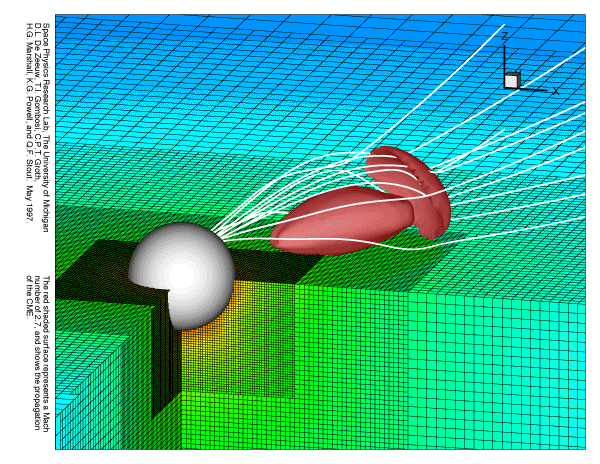
Quentin F. Stout
qstout@umich.edu
http://www.eecs.umich.edu/~qstout/
Darren L. De Zeeuw
darrens@umich.edu
http://www-personal.engin.umich.edu/~darrens
Tamas I. Gombosi
tamas@umich.edu
http://www-personal.engin.umich.edu/~tamas
Clinton P. T. Groth
groth@umich.edu
http://www-personal.engin.umich.edu/~groth
Hal G. Marshall
idaho@umich.edu
http://www-personal.engin.umich.edu/~idaho
Kenneth G. Powell
powell@umich.edu
http://www-personal.engin.umich.edu/~powell
However, there is overhead associated with AMR, in terms of deciding when and how to adapt, and in keeping track of the evolving mesh. One data structure which has been used for AMR is the cell-based tree, which is very flexible and provides a systematic way to keep track of the mesh. However, since each node of a cell-based tree data structure is a single cell, computations suffer from significant overhead due to indirect addressing and lower FLOP rates are achieved. Similar performance issues arise when general unstructured grids are used in place of tree data structures.
For improved computational performance, we have developed adaptive blocks as an alternative data structure to overcome the disadvantages of cell-based trees and unstructured meshes, while still permitting flexible AMR. Adaptive blocks are particularly well suited to high-performance machines, both serial and parallel. For example, our NASA Grand Challenge Team has made use of this data structure in ideal MHD simulations of the solar wind and inner heliosphere ([2]), achieving 16 GFLOPS performance on a 512 node Cray T3D. Figure 1 shows the results of a coronal mass ejection (CME) simulation obtained using the block adaptive MHD model. An adaptive block structure was also used in the first accurate numerical modeling of the recently observed x-ray emissions from comets ([3]),, where these calculations were performed on a workstation.. Other applications and illustrations can be found at our group's web site, http://hpcc.engin.umich.edu/HPCC/. The web site also provides pointers to numerous papers utilizing AMR.

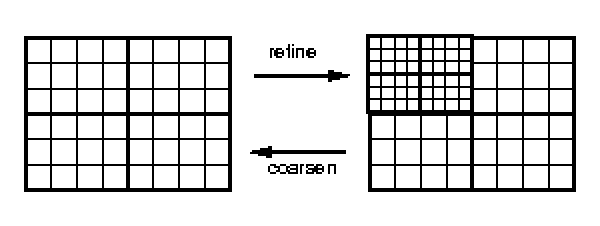
In general adaptive block approach, d-dimensional non-overlapping blocks are used to partition d-dimensional regions of interest. Each block is decomposed into a regular m1 x m2 x ... x md array of cells. When a block is refined, it is replaced by 2d children, each again decomposed into a regular m1 x m2 x ... x md array. In each dimension, the extent of a child's cell is half that of the parent's cell. Coarsening is achieved by reversing this process and replacing the 2d children by their parent. An adaptive block decomposition of a three-dimensional spatial domain is illustrated in Figure 3.
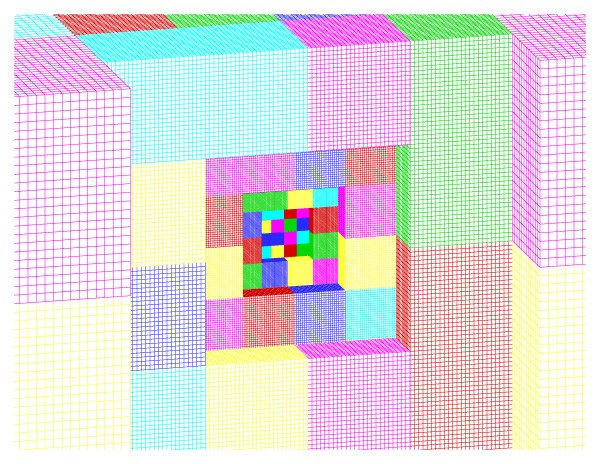
In contrast to adaptive blocks, Figure 4 illustrates a quadtree decomposition. In this cell-based tree decomposition, when a cell is subdivided, the child cells are created and the parent remains, so that the region of the original cell now has two representations. Generalized quadtrees and octrees have been widely used for a variety of two- and three-dimensional applications involving spatial decomposition ([5]). Note that the adaptive blocks for a decomposition of a two-dimensional domain are similar to the leaves of a quadtree decomposition, and in general the adaptive block decomposition of a d-dimensional domain are similar to the leaves of a d-dimensional generalized tree.

Leaves are shown in green. Lines indicate parent-child links.
In the adaptive block data structure, inter-block connectivity is defined using pointers. Each block has pointers to the neighboring blocks with which it shares a face (in other implementations, one may also need pointers to blocks sharing lower dimensional ``faces'' such as edges and corners). Thus neighbor information is maintained explicitly. This is similar to the explicit maintenance of neighbor information in unstructured grids. In contrast, quadtree and octree data structures explicitly maintain only parent-child information and neighbor information must be obtained by a tree traversal.
Note that a block may have many neighbors along a given face, depending on the number of times refinement has occurred among the neighbors. In our applications, we restrict refinement so that neighboring blocks differ by at most one level of resolution. For example, in Figure 2 note the right hand side; if the upper right small block was refined it would cause the upper right large block to also be refined. Refinement can potentially cascade across the grid. For adaptive blocks with at most one level of resolution change between adjacent blocks, there are at most 2d-1 blocks sharing a given face. If k levels of resolution change are permitted, then there can be as many as 2k (d-1) blocks sharing a given face.
In our implementation of the adaptive block data structure, ``ghost'' cells are added around each block, to store values of cells in the neighboring blocks. For first-order accurate spatial operators only one layer of ghost cells is needed; for so-called ``higher-resolution methods'' ([6]), more layers of ghost cells are needed. Prolongation operations are used to determine ghost-cell values when the neighbor block is coarser than the block of interest; restriction operations are used when the neighbor is finer.
However, adaptive blocks can also have some disadvantages when compared to the alternatives. When the size of the array of cells per block is very large, then
The values of the m1, ..., md parameters can be chosen to best trade off the advantages versus the disadvantages. For example, in our three-dimensional MHD implementation on the T3D, the values m1 = m2 = m3 =16 were chosen as a reasonable compromise.
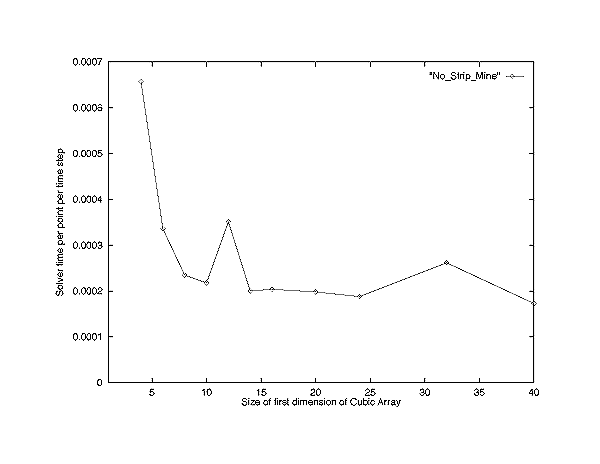
Figure 5 shows a plot of time per cell as a function of the number of cells per block for this implementation. (The smallest block is 2x2x2, rather than a single cell, because it would have required significant rewriting of code to time a true octree.) As can be seen, there is dramatic improvement initially as the size of the blocks increases, but then little additional improvement occurs. The initial improvement is the effect of loop optimizations, and the fact that consecutive cells are brought into cache together. As we had expected, this effect is very significant, more than a factor of 3 improvement over the 2x2x2 case (and far greater over the single cell case). Such improvement was the motivating factor in developing adaptive blocks. These types of loop optimizations are of use on a variety of high performance architectures.
The local maxima shown in the figure are believed to be caused by cache effects on the T3D. For example, the peak at 123 can be removed by padding the array with an additional surface of cells. The peak at 323 can be reduced by data mining the larger blocks into smaller ones; this yields better cache performance and is optimal at sub-block size 163.
However, an aspect of adaptive blocks that is less favorable for parallel computation is the fact that there are far fewer blocks than cells. As noted above, for a given simulation this may result in a small average number of blocks per processor. In such a situation, any processor exceeding the average by only a small number of blocks will have a significant load imbalance, which will reduce parallel efficiency. Choosing overly large blocks will exacerbate this problem. Whenever refinement or coarsening occurs, load re-balancing should be performed to insure high performance.
One critical test of a data structure intended for parallel computers is the achieved scaling as the number of processors increases. In Figure 6 we show the scaleup achieved on the solar wind simulation ([2]) as the problem size was scaled linearly with the number of processors on a Cray T3D.
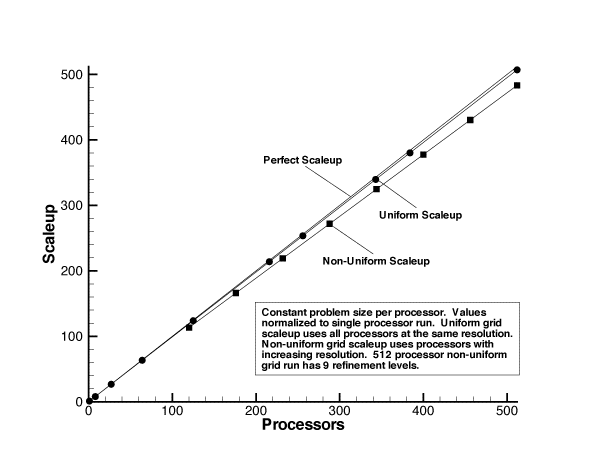
The efficiency is extremely high, even up to 512 processors. Further, the parallel efficiency is being compared to a single processor running adaptive blocks, which is significantly faster than a single processor solving the same problem using a cell based tree.
Another test of the parallel efficiency is the speedup for a fixed size problem. In Figure 7 we show this speedup. Note that it would have been impossible to test this problem on a single processor, because no single processor would have sufficient memory. The speedup here is relative to the 64 processor speed.
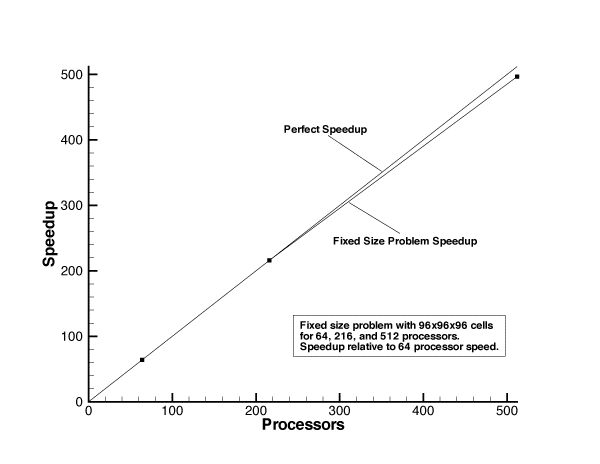
Finally, while our use of adaptive blocks has been motivated by their use in adaptive mesh refinement, the approach can be used for a variety of other problems involving spatial decomposition. Most of their performance advantages would carry over to a wide range of applications, especially when the block size is properly tuned.
2. T. I. Gombosi, K. G. Powell, Q. F. Stout,
E. S. Davidson, D. L. De Zeeuw, L. A. Fisk, C. P. T. Groth, T. J. Linde,
H. G. Marshall, P. L. Roe, B. van Leer, Multiscale modeling of heliospheric
plasmas, High Performance Computing 1997.
3. R. M. Haberli, T. I. Gombosi, D. L. De Zeeuw,
M. Combi, K. G. Powell, Modeling of cometary x-rays caused by solar
wind minor ions, Science 8, May 1997.
4. J. Quirk, An Adaptive Grid Algorithm for
Computational Shock Hydrodynamics, Ph.D. thesis, Canfield Institute
of Technology, 1991.
5. H. Samet, The quadtree and related hierarchical
data structures, Computing Surveys 16 (2), 1984.
6. B. van Leer, Towards the ultimate conservative
difference scheme. V. A second order sequel to Godunov's method,
Journal of Computational Physics 32, 1979.
Quentin F. Stout
is Professor of Computer Science. His research interests are
in parallel computing, especially in the areas of scalable parallel
algorithms and in overcoming inefficiencies caused by interactions among
communication, synchronization, and load imbalance. This work has
been applied to a variety of industrial and scientific parallel computing
problems, as well as to fundamental problems in areas such as sorting,
graph
theory, and geometry. He is Co-Principal Investigator of the NASA
HPCC ESS Computational Grand Challenge Investigator Team at the
University
of Michigan. Home Page.
Darren L. De Zeeuw
is Assistant Research Scientist at the
Space Physics Research Laboratory. His interests involve the
development and implementation of algorithms
to solve the multidimensional Euler and MHD equations using octree-based
unstructured Cartesian grids with adaptive refinement and
multigrid convergence acceleration. He is one of the primary developers
of the code described in this paper. Home Page.
Tamas I. Gombosi
is Professor of Space Science and Professor of Aerospace Engineering.
He has extensive experience in solar
system astrophysics. His research areas include generalized transport
theory, modeling of planetary environments, heliospheric physics,
and more recently, multiscale MHD modeling of solar system plasmas.
He is Interdisciplinary Scientist of the Cassini/Huygens mission to
Saturn
and its moon, Titan.
Professor Gombosi is Senior Editor of the Journal of Geophysical Research
Space Physics.
He is Program Director and Co-Principal Investigator of the NASA
HPCC ESS Computational Grand Challlenge Investigator Team at the
University
of Michigan. Home Page.
Clinton P.T. Groth
is Assistant Research Scientist at the
Space Physics Research Laboratory. His research interests involve
generalized transport
theory and the development of higher-order moment
closures for the solution of the Boltzmann equation via advanced
numerical methods with applications to both rarefied gaseous and
anisotropic plasma flows. This research has led to a new
hierarchy of moment closures with many desirable mathematical
features that appears to offer improved modeling of transitional rarefied
flows. Home Page.
Hal G. Marshall
is Associate Research Scientist at the
Center for Parallel Computing and the Lab for Scientific Computation. He has interests in scientific
computing using massively parallel computers. He is one of the primary
developers
of the code described in this paper. Home Page.
Kenneth G. Powell
is Associate Professor of Aerospace Engineering. His research areas
include:
solution-adaptive schemes, genuinely multidimensional schemes for
compressible flows, and, most recently, numerical methods for
magnetohydrodynamics. He was a National Science Foundation
Presidential Young Investigator from 1988-1994.
He is Co-Principal Investigator of the NASA
HPCC ESS Computational Grand Challlenge Investigator Team at the
University
of Michigan. Home Page.
Author Biographies